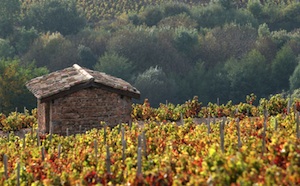AS THE THIRD consecutive “great” Beaujolais vintage reaches market and glasses, the talk in the region has turned to another newcomer, the newly formed appellation of Coteaux Bourguignon.
A rebirth of the now-defunct Bourgogne Grand Ordinaire appellation, AOC Coteaux Bourguignon is a new entry-point Burgundy that can be sourced from anywhere in the Grande Bourgogne region, from Auxerrois in the north, where Chablis is produced, to the southern tip of Beaujolais. The wines are in red, white and rosé styles.
Beaujolais is likely to contribute much of the volume to the appellation, particularly benefiting producers in the sizeable but less marketable southern appellations of Beaujolais (17% of total production) and Beaujolais Village (16%).
Contrary to the successes of the 10 Beaujolais crus in the north of the region (which now constitutes 36% of production), many southern producers have struggled to be profitable.
The long-standing decline of Beaujolais Nouveau, also a product of the south, has hit revenue streams in the past 10 years, dropping from 50% to 31% of the region’s production.
Jean Bourjade, managing director of Inter-Beaujolais, explains that, while the idea hatched in Burgundy, his own region could stand to benefit. “In the southern half of Beaujolais producers suffer from people mixing up Beaujolais and Beaujolais Village with Beaujolais Nouveau, so Coteaux Bourguignon is an opportunity to extend the range of wines they offer to market. Along with red, white, crémant and rosé, it is another option of a diversification strategy.”
Favourably, Coteaux Bourguignon permits an increased yield to Beaujolais appellations (65hl/ha, not 52hl/ha) and for the red, allows the flexibility to use Pinot Noir, Gamay, Tressot, César and can be up to 10% Chardonnay.
The rules also permit semi-carbonic or traditional maceration and the use of oak chips.
According to Xavier Barbet, president of Inter-Beaujolais, producers outside of the 10 crus have been hampered by regulation in the past, but the new appellation provides an opportunity. “We have wonderful terroir but it’s been a long time since we’ve been able to meet the market’s needs,” he said.
Dominique Vrigneau, buying director of UK wine importer Thierry’s, has voiced his support for Coteaux Bourguignon, describing it as an example of how appellations can be innovative and flexible to meet market needs.
“My [first] fear was that it was just a change in the name from Bourgogne Grand Ordinaire to Coteaux Bourguignon, but now I believe the wines will be better. Instead of having a fixed appellation there is a choice for producers. The new rules open things up and allow them to do things differently.”
In some quarters, the move has been seen as the signal of a loss of confidence in the Beaujolais region and a danger to its long-term future.
Georges DuBoeuf, of his eponymous brand – which sold 32 million bottles in 2011 – has said the move will “only help the people of Burgundy”.
The brand’s export director, Bernard Georges, echoed the point: “If you sell wine without your name you lose the face of your wine. This will not help the guy from Beaujolais – it will help the guy from Burgundy.”
Gregory Large, director general of one of the region’s negociants, Mommessin, conceded that if the appellation develops it could eventually see a scaling down of Beaujolais and Beaujolais Village production, but that the move is a positive step for consumers.
“If Coteaux Bourguignon develops, Beaujolais and Beaujolais Villages in the south will be the main source. The appellation could be the flagship of Mommessin wines and a good wine for consumers – it provides value. It has a big opportunity because it is an appellation of liberty.”
Inter-Beaujolais’ Bourjade, though a proponent of the appellation, has also urged caution. “We hope it develops but it’s about diversification – we don’t want it to be too big or too small. We’ve been there with Beaujolais Nouveau – we’ve done it and paid for it. Too much of something is not always good.”




